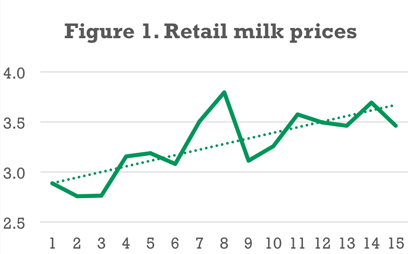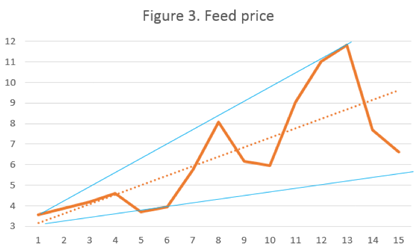Dairy Production: The Challenge Ahead

With feed and milk prices fluctuating it can be difficult gauge how profitable a dairy operation will be year to year.
By: Alvaro Garcia, SDSU Extension Agriculture & Natural Resources Program Director
Consumers are oftentimes surprised by how much milk prices have gone up in recent years. It is not unusual to hear comments making reference to how well dairy farmers are likely doing judging by how much we have to pay for the gallon of milk at the store. Figure 1 shows retail milk prices per gallon throughout the last 15 years. When the peaks and valleys in prices are cancelled out by using an overall trendline (dotted) milk prices increased roughly from $2.9 in 2001 to $3.6 in 2015 or an almost 24% in 15 years.
Farm milk prices in South Dakota, also increased during the same time period showing high variability (Figure 2). Between 2001 and 2015 prices paid for milk went from a base price of $15 to this years’ $16.8. When highs and lows are factored in the net milk farm price increased 55% overall in 15 years.
Although the difference between the increase in price of milk at the store and that received by the farmer seems striking, it does not tell the whole story. To be able to assess if dairy farmers have lost purchasing power during the last 15 years one has to take a look at their cost of production.
The cost of producing milk varies depending on several factors such as size of the farm and the efficiency with which it is operated. Smaller farms usually have larger costs of production per 100 pounds of milk compared to larger operations. These is usually the result of efficiencies of scale in larger operations which gives them more leverage when purchasing inputs. The greatest single item of the cost of production is feed. Depending on the individual farm feed costs per 100 pounds of milk can range between 50 and 70% of the operating costs. Bear in mind these are operating costs (what is needed daily to produce milk) and not total costs. Total costs are much higher since they include other items such as opportunity cost of unpaid labor, capital recovery of equipment, opportunity cost of land (rental rates), taxes and insurance, etc. Figure 3 shows the price of a 16% crude protein dairy ration in South Dakota.
The trendline shows feed prices also increased during this 15-year period, but by almost 300%! To be able to assess how this difference evolved through the years we need to look at the trendline of income over feed costs (figure 4). Although there is a trend for higher income in time, once the peaks and valleys cancel out the trendline shows an increase of only 15% in 15 years (1% per year).
The net loss in purchasing power over the years has left farmers with very little options but to increase production usually through expansion. However what has also increased several fold is the risk of doing so because of the extreme and ever increasing variability from one year to the next (red lines). Expectations for the next 12 months are that milk prices will likely not exceed 16.5 per CWT and could actually drop to 15.5. Dairy farmers have to be really careful with their investments since income over feed costs can easily be cut in half or even more from one year to the next.







